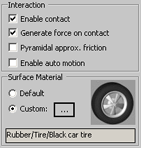Common properties for physical geometries.
Physical geometries inherit basic properties (Common). You may then add specific properties required to handle physics-related aspects:
 |
Inertia Matrix Inertia type: lets you select the type of inertia matrix that the simulator should use for object displacement and inertia effects. By default, rigid bodies are in automatic mode. The overall inertia of the body is established using the inertia matrices of underlying geometries. Mass: indicates the entity's mass. The total mass of a PHX is determined by all of its sub-parts, and is calculated automatically. Note: mass is used only if geometry is connected to a rigid body. In other case, geometry is static an mass is not used. Interaction Enable contact: indicates whether or not the geometry is allowed to collide with others. If this option is deactivated, the collision system ignores the entity when it comes into contact. On the other hand, its mass is still taken into account when calculating the center of gravity and its inertia matrix. Generate force on contact: indicates whether or not the simulator should apply force on the contacts (collisions) generated by the entity. If this option is activated, force is applied upon contact. This option is generally deactivated when you only need information about contact. For example, this is the case when you want to use a geometry as a light bumper. The device attached to the entity may need information about the contact, but you may not necessarily require the robot to react strongly to a collision. Pyramid approx. friction: This option (activated by default) is used by the pyramidal resolution system to calculate friction. This calculation method offers higher precision than constraint force limit (see ODE engine documentation). Calculation time is also longer, since an estimation of effort is required. Note: "constraint force limit" mode (option deactivated) does not really calculate the friction force. It applies the second friction variable defined in the material, that is a constant value that does not take applied effort into account. Enable auto motion: indicates whether or not the surface generates automatic displacement. For example, this option enables you to create conveyors and caterpillar tracks. The surface generates an automatic displacement speed whenever it comes into contact with a geometry. Configure this displacement by clicking on the blue axis that is displayed when this option is selected. Surface Material Default: uses the default material. Custom: uses material from the material library. |
|
Documentation v4.7 (18/01/2015), Copyright (c) 2015 anyKode. All rights reserved.
|
|
What do you think about this topic? Send feedback!
|